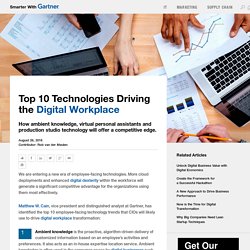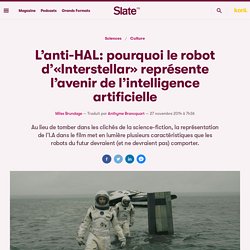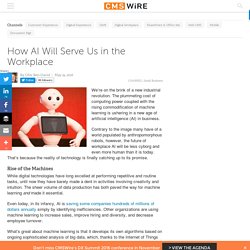

Top 10 Technologies Driving the Digital Workplace. We are entering a new era of employee-facing technologies.

More cloud deployments and enhanced digital dexterity within the workforce will generate a significant competitive advantage for the organizations using them most effectively. Matthew W. Cain, vice president and distinguished analyst at Gartner, has identified the top 10 employee-facing technology trends that CIOs will likely use to drive digital workplace transformation: Ambient knowledge is the proactive, algorithm-driven delivery of customized information based on an employee’s activities and preferences.
It also acts as an in-house expertise location service. The 10 trends also have been visualized in this infographic: L’anti-HAL: pourquoi le robot d’«Interstellar» représente l’avenir de l’intelligence artificielle. Temps de lecture: 5 min Le scénario d'Interstellar gravite surtout autour de l’exploration spatiale, des trous noirs et du voyage dans le temps, et c’est sans surprise que beaucoup de choses ont déjà été écrites sur le traitement de la science dans le film –un livre est même déjà sorti sur le sujet.

Ce dont on a moins parlé, c’est de la représentation de l’intelligence artificielle et de la robotique, sans doute parce que les robots du film fonctionnent tellement bien qu’ils ne perdent jamais la tête et ne tirent pas toute la couverture à eux. Au lieu de tomber dans les clichés de la science-fiction, la représentation de l’I.A dans Interstellar met en lumière plusieurs caractéristiques que les robots du futur devraient (et ne devraient pas) comporter. (Attention: la suite de cet article dévoile des détails-clé de l’intrigue) TARS, le principal robot du film, ne ressemble en rien à un humain. Pour autant, TARS est loin d’être un grille-pain. Droits et besoins des robots. Retooling AI for the workplace.
One of the first computers required punch cards.

I repeat, punch cards. Yes, you would take a piece of paper with tiny holes and use it to interact with the device. Now we have computers the size of soda cans that sit in your house and control your lights, provide weather updates, solve math equations and tell jokes, all by simply speaking to them… and some of them have better jokes than my actual friends. In many ways, we all should have seen this coming — we can thank our Hollywood friends for that. We had C-3PO and R2-D2 running around the galaxy with Luke trying to help him save the universe from his dad. “Artoo says that the chances of survival are 725 to 1. More recently, we’ve had others as full-fledged assistants that are smarter than most humans, like TARS from Interstellar and Jarvis from Iron Man.
As you’re reading this, you’re probably doing some kind of work. Given the massive chunk of our lives spent at work, shouldn’t we enjoy the tools we need to use for our jobs? Voilà. Artificial intelligence in the workplace. How AI will change the modern workplace. Technology is changing the way we live.

Innovative products like smartwatches, virtual assistants like Siri and Cortana, and self-driving cars are raising the bar on expectations. So why shouldn’t that change be reflected in the way we work? Business Insider spoke to Dave Wright, the chief strategy officer at cloud computing business ServiceNow about what they’re doing to improve processes and productivity and the workplace, as well as trends we’re likely to see in the future. But first if you’re not sure what ServiceNow does, here’s how Wright explains it. “The example I always use is Uber,” he says. “If you use Uber, you go in and you request what type of car you want, and what they give you — that you don’t need but you love — is the screen with all the little cars on it. “Imagine if you requested something off marketing, and you could see what stages it was going to go through; where it was, when you were going to get it. How AI Will Serve Us in the Workplace.
We’re on the brink of a new industrial revolution.

The plummeting cost of computing power coupled with the rising commodification of machine learning is ushering in a new age of artificial intelligence (AI) in business. Contrary to the image many have of a world populated by anthropomorphous robots, however, the future of workplace AI will be less cyborg and even more human than it is today. That’s because the reality of technology is finally catching up to its promise. Rise of the Machines While digital technologies have long excelled at performing repetitive and routine tasks, until now they have barely made a dent in activities involving creativity and intuition.
Even today, in its infancy, AI is saving some companies hundreds of millions of dollars annually simply by identifying inefficiencies. One of the many benefits of machine learning is that it has the potential to eliminate the human propensity to mistake correlation for causation. The Enlightened Executive The Empowered Customer.